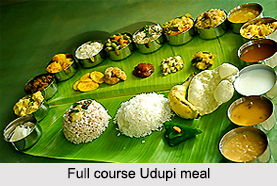 Udupi cuisine is a renowned cuisine of South India and it forms an important part of the cuisine of Karnataka. Udupi cuisine takes its name from Udupi, a city on the southwest coast of India in Karnataka. This cuisine has its origin in the Ashta mathas of Udupi which was discovered by Shri Madhvacharya. Udupi cuisine consists of dishes that are made of grains, beans, vegetables and fruits. Udupi cuisine comprises recipes made primarily from grains, beans, vegetables, and fruits. The variety and range of dishes are wide, and a hallmark of the cuisine involves the use of locally available ingredients.
Udupi cuisine is a renowned cuisine of South India and it forms an important part of the cuisine of Karnataka. Udupi cuisine takes its name from Udupi, a city on the southwest coast of India in Karnataka. This cuisine has its origin in the Ashta mathas of Udupi which was discovered by Shri Madhvacharya. Udupi cuisine consists of dishes that are made of grains, beans, vegetables and fruits. Udupi cuisine comprises recipes made primarily from grains, beans, vegetables, and fruits. The variety and range of dishes are wide, and a hallmark of the cuisine involves the use of locally available ingredients.Main Ingredients of Udupi Cuisine
Udupi cuisine is famous among the entire southern part of India. Udupi cuisine is confined to the Vedic tradition of Indian vegetarian cuisine. It adheres to the Satvik tradition of Indian cooking, which means using no onion, garlic, meat, fish or poultry.
Pumpkins and gourds are the main ingredients in sambar. Masala dosa has its origins in Udupi. Saaru is spicy pepper water which is an essential part of the menu. Dumplings, dry curries and chutneys are major specialties. Fruits are also an essential part of Udupi cuisine. One can try out dishes made of raw banana, jackfruit, pumpkin, breadfruit, etc.
Full Course Udupi Meal
A full course Udupi meal is served on a plantain leaf, which is kept on the ground. The dishes are served in a sequence. One should start the meal by saying "Govinda," the name of Lord Vishnu and end also in the same manner. The meal comprises of Ghee, Salt, Pickle, Kosambari, Bajji or chutney, Ajethna, Spiced rice, Appalla, Steamed rice, Saaru and Rasam, Menaskai, and Koddelu. The meal also includes sweets like laddu, holige; fried items like bonda, chakkuli, vada and desserts like paramanna or kheer or payasa, buttermilk/ curd.
The full course Udupi meal is served on a plantain leaf, which is traditionally kept on the ground. The dishes are served in a particular sequence, and each dish is placed on a particular spot of the plantain leaf. All the people eating this meal are expected to begin and end eating the meal together. A person cannot get up in middle of the meal, even though he has finished his meal.
For more, visit the link below: